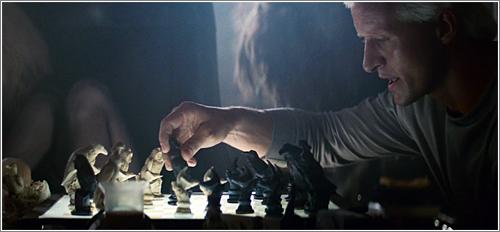
In Defense of Descriptive Notation
Descriptive Notation Gets Bad Press
The reason descriptive is confusing to modern players is that each square has two designations, depending on who has moved. Every file is known by the piece that starts the game on that file; for example, the King (K) File, the King’s Bishop (or simply King Bishop or KB) file, Queen Knight (QN) file, etc.
Every rank does double duty, though! The b5 square in algebraic is QN5 when White moves there and it is QN4 when Black moves there. That is because the ranks are numbered relative to the color moving. White’s home rank is the 1st rank for White, but it is the 8th rank for Black!

Some useful information is lost if the descriptive idea is completely abandoned. It is actually useful to divide the board according to the two opposing armies. There is a “White Side” and a “Black Side.” Each side has its own “home turf” and then there is “enemy territory.” Every square up to the middle of the board (the 4th rank) is home turf. Every square beyond is enemy territory. If you influence more squares in enemy territory (beyond the 4th rank) than your opponent influences in your home turf, then you have a space advantage. It is that simple. Many descriptive terms have survived into the algebraic age. Concepts like the “center” and “central” squares. The “7th rank” (it is a killer advantage to have an unassailable rook there!) and the “back rank” are useful carry-overs. The idea of the “wing” or the “flank” and the “rim” or “rook file(s)” are also usefully carried over terms. Let’s look more closely at what these mean and how they are useful.
The Center and the Central Squares
At first blush it may seem that the “center” and the “central squares” are the same thing but there is a difference. The actual center consists of the squares e4, d4, d5, and e5 … or K4 (King Four), Q4 (Queen Four), Q5 and K5 in the descriptive system. Just remember that White’s K4 is Black’s K5 and vice verse! Some people refer to these squares as the “Sweet Center.” The “Central Squares” are the center and all the squares immediately surrounding it.
Why Central Squares are Important
The knight is the most limited minor piece. At the most it influences 8 squares. If it is not on a central square then it influences less than 8 squares. Its movement effectiveness is reduced when not centralized. That’s why coaches school their pupils to always centralize!
All of the pieces have greater mobility from the central squares, with one exception that may surprise you. If you place a rook anywhere on an empty board then it is capable of going to 14 squares. No matter where you put it, it can move to 14 squares. Try it!
If you place a bishop on a center square it has 13 moves available. Its options decrease to 11 possible moves from a non-center, but central square. Since a queen combines the movement powers of rook and bishop it has 27 possible moves from the center – almost half of the board! This is why the center and centralization is important. Mobility is the source of power in chess.
Wings and Flanks
Other useful descriptive ideas are wings and flanks. The wings are divided into two right/left sides; the kingside and the queenside. The flanks typically refer to the bishop, knight and rook files on each side. When the center is locked up then play typically moves to the flanks. There is a reverse corollary to this idea, too – a premature flank attack is best met by action in the center. That’s why strong players never start a kingside or queenside attack until the center is secure.
The 7th Rank and the Back Rank
A couple other useful ideas by description are the concepts of the 7th rank and the back rank.
Rooks consider arriving safely to the 7th rank – the rank in front of the enemy’s home rank – a dream come true. Having two rooks on the 7th is almost a sure win. I have heard some people call that “two pigs on the 7th” because they can just about eat everything up.
Also, who has not fallen victim to a weak back rank attack – or even the threat of it?
Descriptive Conclusion
Embrace descriptive ideas about the chessboard. You hear about them all the time but just didn’t realize it! If you get bit by the descriptive bug then learn to record your games in descriptive notation! Believe it or not, the game may seem to come more to life because it paints a colorful picture of where the action is more than the stethoscope coldness of algebraic notation.

One of Bobby Fisher's Score Sheets in Descriptive Notation